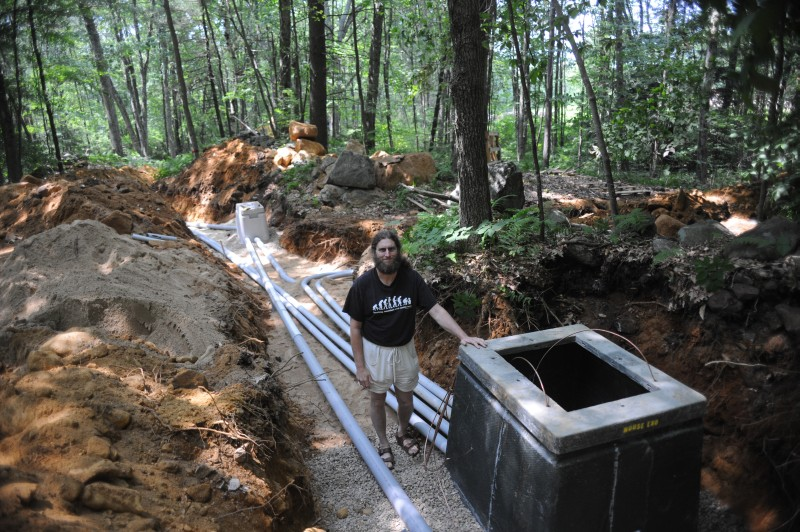Climate change in Harvard Forest is a pressing reality that researchers have been observing with increasing concern. Nestled in Petersham, Massachusetts, this 4,000-acre woodland has been a focal point for Harvard Forest research, where scientists like David Orwig and Emery Boose document the profound shifts occurring within this forest ecosystem. As warming temperatures alter the landscape, the impacts of invasive species, such as the damaging woolly adelgid, become increasingly evident, threatening the resilience of forests. Over the years, significant changes have been recorded, from the declining hemlocks to the rise of black birches, highlighting how climate change impacts biodiversity and ecosystem dynamics. This transformation not only affects the flora and fauna present but also poses critical questions about the future of forest conservation efforts in the face of an unstable climate.
The phenomenon of climate change in Harvard Forest serves as a microcosm for broader environmental shifts observed globally. Investigative studies conducted at this site illustrate how alterations in temperature and precipitation patterns are reshaping forest ecosystems and influencing ecological stability. With a focus on understanding the resilience of forests amidst these changes, researchers document the arrival of invasive pests and their repercussions on native species. As new botanical landscapes emerge, characterized by shifting species dynamics and soil chemistry, a comprehensive understanding of these environmental challenges becomes essential. Such insights not only inform scientific discourse but also guide conservation strategies to preserve the ecological integrity of our woodlands.
The Transformative Impact of Climate Change on Harvard Forest
Harvard Forest, a 4,000-acre research site in Massachusetts, has been a focal point for understanding the ramifications of climate change on forest ecosystems. The ongoing research here vividly illustrates that the landscape is not only changing but also evolving due to the direct impacts of climate change. Over the past few decades, researchers have observed a significant transformation in the forest’s canopy and understory, with noticeable shifts in species composition. These alterations, such as the flourishing of black birch trees in place of dying hemlocks, highlight the complex interactions between climate dynamics and ecological responses. Such developments serve as a stark reminder that the implications of climate change are not merely theoretical discussions but tangible realities currently unfolding at Harvard Forest.
The data collected at Harvard Forest extends back to the 1960s, allowing researchers to recognize long-term trends in temperature and precipitation. These climate change impacts reveal a warming and increasingly wet climate, which correlates with heightened variability in seasonal weather patterns. Consequently, this changing climate poses challenges to forest ecosystems, pushing native species to adapt or retreat. The ability to glean insights from decades of research, combined with immediate observations, has positioned Harvard Forest as a critical lab for exploring how climate change is reshaping our natural landscapes.
Resilience of Forest Ecosystems Under Climate Stress
As a living laboratory, Harvard Forest embodies both the resilience of forest ecosystems and the challenges they face under climate stress. The observed changes brought about by climate change indicate that forests are dynamic systems capable of adapting to new conditions, albeit at a potentially high ecological cost. The resilience of these ecosystems is particularly evident as they transition from hemlock-dominated canopies to those led by black birch and other species. This shift is not merely a loss but a transformation, as new species take up ecological roles that may alter nutrient cycling and community dynamics within the forest.
Research at Harvard Forest underscores the importance of understanding the ecological balance as invasive species, such as the woolly adelgid, exacerbate the stresses on native trees like hemlocks. The interplay of climate change and invasive species raises questions about the long-term sustainability of these ecosystems. Yet, despite these challenges, the researchers express a profound sense of wonder at the forest’s ability to rebound and adapt. By monitoring changes in species composition and ecosystem functions, scientists are gaining valuable insights into how resilience can be fostered in forests facing climate change threats.
Invasive Species and Ecosystem Dynamics at Harvard Forest
Invasive species are playing a pivotal role in shaping the ongoing changes within Harvard Forest, adding another layer of complexity to the effects of climate change. The arrival of pests like the woolly adelgid has put native hemlock populations at risk, creating a ripple effect throughout the ecosystem. This invasive insect has thrived in the milder winters attributed to climate change, further accelerating the decline of this once-abundant tree species. As the hemlocks suffer, the forest’s overall structure and function shift, resulting in altered light levels and soil chemistry that favor other tree species, such as the black birch.
This dynamic illustrates the interconnectedness of climate influences and biological invasions, as the health of a single species can dramatically affect the broader forest ecosystem. Researchers at Harvard Forest are keenly aware that combating invasive species is essential not only for preserving biodiversity but also for maintaining the resilience of the ecosystem. Understanding these interactions is vital for developing effective management and conservation strategies to buffer the impacts of climate change and safeguard the future of forest ecosystems.
Long-term Research Insights from Harvard Forest
The long-term research programs at Harvard Forest provide invaluable insights into the historical and ongoing impacts of climate change on forest ecosystems. With over a century of data collection and a multitude of active research projects, the forest serves as a living archive of environmental changes. Scientists analyze temperature and precipitation records spanning decades, allowing for the identification of patterns that inform both current and future ecological trends. This wealth of information enables researchers to model potential future scenarios and understand how forests might continue to respond to an ever-changing climate.
Moreover, Harvard Forest’s data plays a crucial role in shaping broader discussions about climate resilience and adaptation strategies. By studying microclimatic conditions and their influence on tree growth and health, researchers are shedding light on how different species cope with increasing temperature and precipitation variability. Such knowledge not only serves academia but also informs forest management practices, conservation efforts, and policy-making aimed at bolstering forest resilience against climate change.
Community Engagement in Climate Research at Harvard Forest
The spirit of community engagement is palpable at Harvard Forest, where researchers foster a collaborative environment that encourages public involvement in scientific inquiry. Events, educational programs, and outreach efforts bridge the gap between research and the local community, helping to disseminate knowledge about climate change impacts on forests. Visitors and participants gain firsthand experience in observing the changes within the forest, fostering a sense of stewardship and responsibility towards this valuable natural resource.
By integrating community perspectives, Harvard Forest not only enhances scientific understanding but also cultivates a shared commitment to addressing climate change challenges. The narratives of individuals working at the forest amplify the urgency of climate action while highlighting the interconnectedness of human experiences with the natural world. This collective approach to climate research ensures that the insights gained resonate beyond the scientific community, inspiring further advocacy and education efforts geared towards forest preservation and climate resilience.
The Role of Longitudinal Studies in Understanding Ecosystem Changes
Longitudinal studies conducted at Harvard Forest are instrumental in unraveling the complexities of ecosystem changes due to climate dynamics. By continuously monitoring specific areas over time, researchers can track trends in flora and fauna, elucidating how species adapt to shifting conditions. These studies emphasize the importance of temporal data in revealing long-term environmental shifts that often escape short-term observations. The collected data serve as a valuable resource for anticipating future changes within the forest ecosystem.
The rigorous documentation of these changes empowers researchers to draw connections between climate variables and their ecological impacts. Longitudinal studies at Harvard Forest are particularly relevant as they reveal how climatic shifts influence species distribution, community dynamics, and overall forest health. These data sets not only enrich scientific literature but also provide essential information for land management practices aimed at fostering resilience amid ongoing climate change.
Climate Change and Shifting Forest Baselines at Harvard Forest
The concept of shifting baselines, introduced by Harvard Forest’s Director, underscores the profound implications of climate change on our perception of forest ecosystems. As climate conditions evolve, supporting a different assemblage of species, future generations may have vastly different experiences and expectations of forests compared to those who have lived through more stable climates. This shift in baseline perceptions highlights the urgency of understanding and communicating the impacts of climate change, not only scientifically but also culturally and socially.
In a world where rising temperatures alter ecosystems over time, Harvard Forest emphasizes the importance of embedding historical context into current climate conversations. By articulating the dramatic changes experienced in forestry landscapes, researchers highlight the need for comprehensive education on ecological dynamics and conservation strategies. Continuous engagement with the public about these shifting baselines fosters a greater appreciation for the natural world, sparking proactive measures to mitigate the effects of climate change.
Implications of Seasonal Change on Biodiversity at Harvard Forest
Seasonal changes at Harvard Forest have begun to manifest distinct effects on local biodiversity, reshaping the ecological landscape. Changes in winter temperatures and precipitation patterns have led to altered timings of biologically significant events, such as flowering and leaf-out periods for various plant species. These shifts can disrupt pollinator interactions and subsequently affect food webs, showcasing the interconnectedness of climate phenomena and ecosystem health. Researchers are intensely studying these impacts to better understand the potential consequences of a warming climate on biodiversity.
The vitality of diverse ecosystems hinges on the synchronization of seasonal events among species. Abnormal temperature fluctuations and variability in precipitation can misalign these crucial phenomena, posing risks to both flora and fauna. As temperatures rise, forests like those at Harvard Forest face the challenge of sustaining biodiversity amidst such changes, further emphasizing the need for continued research into climate influences on these vital ecological processes. Understanding these relationships is essential for devising effective conservation strategies.
Community Resilience and Adaptation Strategies in the Face of Climate Change
Amidst the evident impacts of climate change on forest ecosystems, the community surrounding Harvard Forest has taken significant strides toward resilience and adaptation. By actively participating in research initiatives and educational outreach, community members are becoming more informed about the effects of climate change on their local environments. This shared knowledge fosters a proactive stance on environmental stewardship and collaborative efforts towards climate adaptation, which are crucial in ensuring the sustainability of local ecosystems.
Community-led initiatives, informed by ongoing research at Harvard Forest, aim to enhance the resilience of both natural and human systems. By integrating traditional ecological knowledge with scientific findings, communities can create adaptive strategies that promote biodiversity conservation and sustainable land use practices. Such grassroots efforts contribute to a broader narrative of climate action, illustrating how local engagement can support larger conservation goals amidst a changing climate.
Frequently Asked Questions
What are the main climate change impacts observed in Harvard Forest?
Research at Harvard Forest shows significant climate change impacts, including warmer winters, increased rainfall variability, and shifting forest ecosystems. Senior ecologist David Orwig noted that the understory has changed dramatically, showing a rise in black birches as hemlocks decline due to invasive species like the woolly adelgid. These changes are critical as they alter the landscape’s biodiversity and overall ecosystem health.
How does climate change affect the resilience of forests at Harvard Forest?
The resilience of forests at Harvard Forest is challenged by climate change, which causes shifts in species composition and ecosystem dynamics. While black birches are replacing dying hemlocks, this transformation alters soil chemistry and nutrient cycling. The forest is adapting, but the overall composition and function of the woodlands are continuously modified by warming temperatures and invasive species impacts.
What role do invasive species play in climate change impacts at Harvard Forest?
Invasive species like the woolly adelgid significantly exacerbate the effects of climate change at Harvard Forest. As milder winters allow these pests to thrive, they contribute to the decline of keystone species like hemlocks, altering the forest’s structure and function. This dynamic underscores the interconnectedness of invasive species and climate change in shaping forest ecosystems.
How does Harvard Forest’s research contribute to understanding climate change?
Harvard Forest’s long-term climate data, dating back to the 1960s, is invaluable for understanding climate change trends. By studying the interactions between temperature, precipitation, and forest responses, researchers can identify how climate change impacts ecosystems over time. This research not only informs scientists about ongoing changes but also aids in developing strategies for forest management and conservation.
What future changes might we see in Harvard Forest due to climate change?
Future changes in Harvard Forest may include increased species turnover as invasive species gain ground, altered precipitation patterns leading to heavy rain events, and an ongoing transformation of the forest structure. As temperatures continue to rise, researchers like Emery Boose anticipate further shifts in the forest ecosystem dynamics, highlighting the importance of monitoring these changes for future conservation efforts.
How do changing winter conditions affect Harvard Forest’s ecosystem?
Changing winter conditions at Harvard Forest, characterized by shorter snow seasons and milder temperatures, impact soil health and the seasonal cycles of flora and fauna. Vital snowpack that once insulated soil is now thinner, affecting the temperature and moisture regime of the forest. This disruption can lead to increased vulnerability of native species and altered ecological relationships.
What are the implications of ‘shifting baselines’ in the context of climate change at Harvard Forest?
The concept of ‘shifting baselines’ signifies how perceptions of what constitutes a ‘normal’ forest ecosystem change across generations, particularly at Harvard Forest. As climate change continues to alter the forest landscape, new generations may lack the perspective of historical ecosystems, which affects conservation priorities and scientific inquiry aimed at preserving biodiversity.
| Key Point | Details |
|---|---|
| Researchers’ Observations | Emery Boose and Clarisse Hart study changes at Harvard Forest, noting stark contrasts in forest conditions over decades. |
| Impact of Climate Change | Long-term warming trends leading to changes in species composition and forest dynamics. |
| Data Repository | Harvard Forest has extensive climate data dating back to the 1830s to inform their studies. |
| Experiments and Research | Around 100 research projects ongoing to study various aspects of forest ecology under climate change. |
| Species Changes | Invasive species like the woolly adelgid threaten native hemlocks, altering the forest’s ecosystem. |
| Community Impact | Local researchers express deep personal connections to the forest, observing both loss and resilience. |
| Educational Outreach | Clarisse Hart emphasizes the importance of community engagement and education about climate impacts. |
Summary
Climate change in Harvard Forest is an urgent and visible reality for researchers and the local community. Deep personal connections to the land fuel the work of scientists like Emery Boose and Clarisse Hart, who consistently observe the changing ecosystem. From invasive species threatening native trees to altered forest dynamics, the Harvard Forest presents a living laboratory for studying and understanding the impacts of climate change in real-time. With extensive data and ongoing research, the urgency to address these changes underscores the need for collective awareness and conservation effort.



